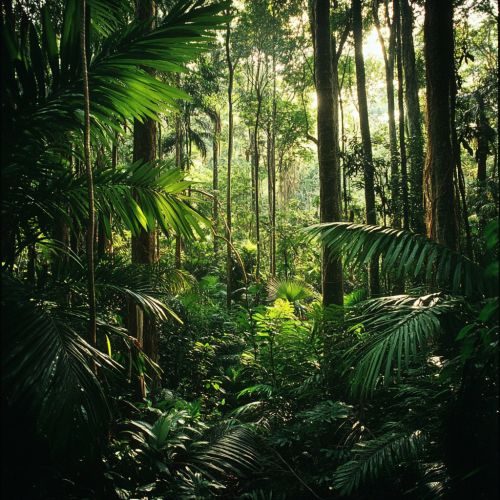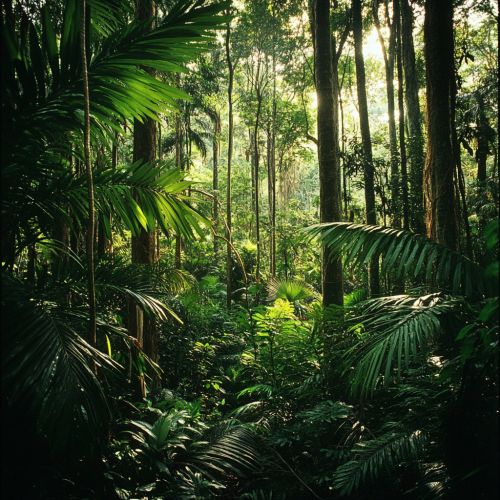Terrestrial ecosystems
Introduction
Terrestrial ecosystems are complex networks of living organisms and their physical environment, interacting as a functional unit on land. These ecosystems encompass a wide range of habitats, from forests and grasslands to deserts and tundras. Each type of terrestrial ecosystem has unique characteristics, driven by factors such as climate, soil type, and the presence of specific plant and animal species. Understanding these ecosystems is crucial for biodiversity conservation, climate change mitigation, and sustainable land management.
Types of Terrestrial Ecosystems
Terrestrial ecosystems can be broadly categorized into several types, each with distinct features and ecological dynamics. These include forests, grasslands, deserts, tundras, and mountain ecosystems.
Forest Ecosystems
Forest ecosystems are dominated by trees and other woody vegetation. They are classified into several subtypes based on climatic conditions and geographical location:
Tropical Rainforests
Tropical rainforests are located near the equator and are characterized by high rainfall, humidity, and biodiversity. These forests have a multi-layered structure, including emergent trees, a canopy, understory, and forest floor. They are home to numerous species of plants, animals, and microorganisms.


Temperate Forests
Temperate forests are found in regions with moderate climates, characterized by distinct seasons. They include deciduous forests, where trees shed their leaves annually, and evergreen forests, where trees retain their foliage year-round. These forests support a diverse array of flora and fauna.
Boreal Forests
Boreal forests, also known as taiga, are located in high-latitude regions with cold climates. They are dominated by coniferous trees such as pines, spruces, and firs. These forests play a crucial role in carbon sequestration and provide habitat for species adapted to cold environments.
Grassland Ecosystems
Grasslands are ecosystems where grasses dominate the vegetation. They are found in regions with moderate rainfall and are classified into two main types:
Tropical Grasslands (Savannas)
Tropical grasslands, or savannas, are characterized by a mix of grasses and scattered trees. They are found in regions with seasonal rainfall and support a variety of herbivores and predators. Savannas are known for their role in supporting large migratory herds and diverse wildlife.
Temperate Grasslands
Temperate grasslands, also known as prairies or steppes, are found in regions with moderate rainfall and distinct seasons. They have rich soils that support extensive agriculture. These ecosystems are home to numerous grass species and a variety of herbivores and predators.
Desert Ecosystems
Deserts are characterized by low rainfall and extreme temperature variations. They are classified into hot deserts and cold deserts:
Hot Deserts
Hot deserts, such as the Sahara and the Sonoran Desert, experience high temperatures during the day and cool temperatures at night. They have sparse vegetation, including cacti and succulents, and are home to specially adapted animals such as reptiles and nocturnal mammals.
Cold Deserts
Cold deserts, such as the Gobi Desert and the Great Basin Desert, experience cold winters and moderate summers. They have low precipitation and support vegetation such as shrubs and grasses. These deserts are home to species adapted to cold and arid conditions.
Tundra Ecosystems
Tundra ecosystems are found in high-latitude regions and are characterized by cold temperatures, low precipitation, and permafrost. They are classified into two types:
Arctic Tundra
Arctic tundra is located in the northernmost regions of the Earth. It has a short growing season and supports low-growing vegetation such as mosses, lichens, and dwarf shrubs. The fauna includes migratory birds, caribou, and Arctic foxes.
Alpine Tundra
Alpine tundra is found in high-altitude regions, such as mountain ranges. It has similar characteristics to the Arctic tundra but is influenced by altitude rather than latitude. The vegetation includes grasses, sedges, and dwarf shrubs, and the fauna includes mountain goats and marmots.
Mountain Ecosystems
Mountain ecosystems are characterized by their elevation and topography, which create diverse microclimates and habitats. They support a wide range of plant and animal species adapted to varying conditions. These ecosystems play a crucial role in water regulation and provide habitat for endemic species.
Ecological Processes in Terrestrial Ecosystems
Terrestrial ecosystems are governed by various ecological processes that maintain their structure and function. These processes include primary production, nutrient cycling, and energy flow.
Primary Production
Primary production is the process by which plants convert sunlight into chemical energy through photosynthesis. This energy forms the basis of the food web, supporting herbivores, carnivores, and decomposers. The rate of primary production varies among different ecosystems, influenced by factors such as climate, soil fertility, and water availability.
Nutrient Cycling
Nutrient cycling involves the movement and transformation of essential elements such as carbon, nitrogen, and phosphorus within an ecosystem. These cycles are driven by biological, chemical, and physical processes. Decomposers play a crucial role in breaking down organic matter and releasing nutrients back into the soil, making them available for plant uptake.
Energy Flow
Energy flow in terrestrial ecosystems follows a unidirectional path from primary producers to various trophic levels. Herbivores consume plants, carnivores consume herbivores, and decomposers break down dead organic matter. Energy is lost at each trophic level through respiration and metabolic processes, resulting in a decrease in available energy as one moves up the food chain.
Human Impact on Terrestrial Ecosystems
Human activities have significantly altered terrestrial ecosystems, leading to habitat loss, pollution, and climate change. These impacts have far-reaching consequences for biodiversity and ecosystem services.
Habitat Loss and Fragmentation
Habitat loss and fragmentation result from activities such as deforestation, urbanization, and agriculture. These processes reduce the available habitat for species, leading to population declines and increased vulnerability to extinction. Fragmented habitats also disrupt ecological processes and reduce genetic diversity.
Pollution
Pollution from industrial, agricultural, and urban sources contaminates soil, water, and air, affecting the health of terrestrial ecosystems. Chemical pollutants, such as pesticides and heavy metals, can accumulate in the food web, causing toxic effects on wildlife and humans.
Climate Change
Climate change, driven by greenhouse gas emissions, is altering temperature and precipitation patterns, affecting the distribution and functioning of terrestrial ecosystems. Changes in climate can lead to shifts in species ranges, altered phenology, and increased frequency of extreme weather events. These changes pose significant challenges for ecosystem resilience and biodiversity conservation.
Conservation and Management of Terrestrial Ecosystems
Conservation and sustainable management of terrestrial ecosystems are essential for maintaining biodiversity and ecosystem services. Various strategies and approaches are employed to achieve these goals.
Protected Areas
Protected areas, such as national parks and nature reserves, are established to conserve biodiversity and protect critical habitats. These areas provide refuge for species and serve as benchmarks for ecological research and monitoring.
Restoration Ecology
Restoration ecology involves the rehabilitation of degraded ecosystems to restore their structure and function. Techniques such as reforestation, soil remediation, and invasive species control are used to enhance ecosystem resilience and biodiversity.
Sustainable Land Management
Sustainable land management practices aim to balance human needs with ecological integrity. Approaches such as agroforestry, conservation agriculture, and integrated pest management promote sustainable use of land resources while minimizing environmental impacts.
Conclusion
Terrestrial ecosystems are vital components of the Earth's biosphere, supporting diverse life forms and providing essential ecosystem services. Understanding the complexity and dynamics of these ecosystems is crucial for their conservation and sustainable management. Human activities pose significant threats to terrestrial ecosystems, but through concerted efforts in conservation and sustainable practices, it is possible to mitigate these impacts and ensure the long-term health and resilience of these ecosystems.
